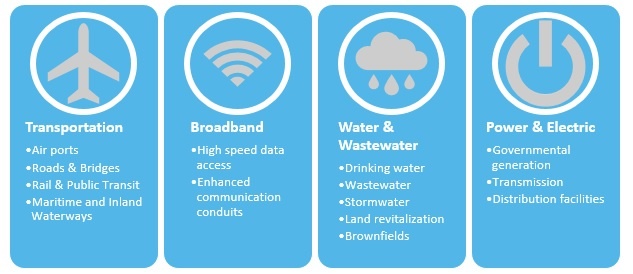An Executive Approach to Accelerating Rural Economy
February 28, 2018 •Summit Consulting

This blog was written by Ian Weise and George Voris.
The White House Infrastructure Plan proposes the creation of a new program, the Rural Infrastructure Program. This program aims to accelerate infrastructure investment in our nation’s rural economy and targets regions with populations of less than 50,000. Under this program, $50 billion in grants would be made available to states, tribes, and territories to finance a variety of assets. In addition to directly funding the asset classes portrayed below, these grants could be used to fund infrastructure directly attributable and essential to the operation of these assets.
The proposal suggests two main types of grant funding: block grants and rural performance grants. 80 percent of the funding (i.e. $40B) would be provided to state Governors as block grants, based on a “formula distribution”. The details of the formula will be clarified in legislation and/or regulations, but formula inputs will include rural lane miles and rural population. To avoid disproportionate distribution of the grant funding among states, states would receive no more and no less than a statutory maximum and minimum, respectively.
Eligible Asset Classes - Rural Infrastructure Program

20 percent of the funding (i.e. $10B) would be used to provide rural performance grants. State Governors may apply for these grants within two years of the program’s creation, in addition to the block grant funding they would receive. To receive a rural performance grant, a state must:
- Create a comprehensive Rural Infrastructure Investment Plan (RIIP) describing how the projects included in the plan align with the selection criteria for the Infrastructure Incentives Program;
- Provide a demonstration of the quality of any investments planned within the rural performance funds;
- Show how block grants can be leveraged with federal credit programs and the infrastructure incentives program; and
- Demonstrate that block grant funding is being used in adherence with the RIIP.
The Rural Infrastructure Program would also support investment in tribal and territorial infrastructure. According to the proposal, an undefined amount would be set aside to be distributed to the Tribal Transportation Program. A portion of the $50 billion would be dedicated to finance infrastructure needs in U.S. territories.
The objective of the Rural Infrastructure Program is clearly to provide grant funding for rural infrastructure projects. However, questions remain regarding program’s implementation. The USDA Rural Development (USDA RD) is likely best suited to implement the program, due to its existing decentralized program structure. As USDA RD leans heavily on state offices to implement its credit programs, states may be granted authority to select which projects to fund with its block grants. The lead agency, likely USDA RD, may dictate some additional criteria that must be met in the rulemaking process. Furthermore, the plan describes application requirements for the rural performance grants but it does not clarify how these grants will be awarded. The legislation or regulations may define a competitive process, or a first in, first out method. If it is a competitive process and funds are not drawn down over an extended period, will funds be made available to states that were not selected to receive the performance grants?
RD’s existing credit and grant programs currently offer subsidized credit assistance to rural communities with small population sizes. The additional funding will probably benefit currently eligible borrowers and grantees by increasing available funding. In addition, one of the main impacts of the proposed program is the larger population size limit. This program will make grant funding available to communities that were too large for many of the existing RD programs, but too small to enjoy the economies of scale enjoyed by large metropolitan areas.
States may be able to leverage their existing state infrastructure banks, state revolving funds, and state RD offices to administer the program. Due in part to their familiarity and proximity to projects in their state, states often have a better understanding of the local needs, and are often better positioned than the Federal Government to assess the significance of those projects for the state. In some cases, state and local governments have more streamlined grant application and approval processes compared to the Federal Government. Combined, these attributes give way to quicker and more targeted investment in rural infrastructure.
In the final post of this series, Summit will review the potential benefits of the proposed Transformative Projects Program in the White House Infrastructure Proposal.
Get Updates
Featured Articles
Categories
- affordable housing (12)
- agile (3)
- AI (4)
- budget (3)
- change management (1)
- climate resilience (5)
- cloud computing (2)
- company announcements (15)
- consumer protection (3)
- COVID-19 (7)
- data analytics (82)
- data science (1)
- executive branch (4)
- fair lending (13)
- federal credit (36)
- federal finance (7)
- federal loans (7)
- federal register (2)
- financial institutions (1)
- Form 5500 (5)
- grants (1)
- healthcare (17)
- impact investing (12)
- infrastructure (13)
- LIBOR (4)
- litigation (8)
- machine learning (2)
- mechanical turk (3)
- mission-oriented finance (7)
- modeling (9)
- mortgage finance (10)
- office culture (26)
- opioid crisis (5)
- Opportunity Finance Network (4)
- opportunity zones (12)
- partnership (15)
- pay equity (5)
- predictive analytics (15)
- press coverage (3)
- program and business modernization (7)
- program evaluation (29)
- racial and social justice (8)
- real estate (2)
- risk management (10)
- rural communities (9)
- series - loan monitoring and AI (4)
- series - transforming federal lending (3)
- strength in numbers series (9)
- summer interns (7)
- taxes (7)
- thought leadership (4)
- white paper (15)


